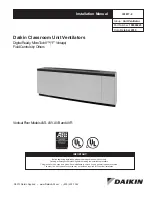
Recommended
Action
Adjust cooling for higher room temperature set point.
(Turn cooling thumbwheel out.)
Therma-Fuser diffuser is correct. Check if cooling is
still required, and if not, turn cooling unit off.
Therma-Fuser diffuser is correct. Check for lack of
air or for too warm air temperature.
Adjust cooling for lower room temperature set point.
(Turn cooling thumbwheel in.)
Therma-Fuser diffuser is correct. Check for lack of
air or too low air temperature.
Adjust heating for higher room temperature set point.
(Turn heating thumbwheel out.)
Adjust heating for lower room temperature set point.
(Turn heating thumbwheel in.)
Therma-Fuser diffuser is correct. Check if heating is
still required, and if not, turn it off.
Reduce static pressure. Recommended static pres-
sure is .05 to .25 wg / 10 to 62 Pa at the inlet of the
diffuser. If lower noise level does not result from
lower static pressure, check for and correct noise
generating restrictions in the duct up stream such as
large pressure drops over dampers, heaters, etc.
Disc
Position
Open
Closed
Open
Closed
Open
Closed
Open
Closed
Any
Room
Temp.
Too
Cold
Too
Warm
Too
Cold
Too
Warm
Any
Cooling
Mode
ST-C
ST-HC
Heating
Mode
ST-HC
Too
Noisy
ST-C
ST-HC
Page 3
MAINTENANCE
The moving parts of the ST Therma-Fuser diffuser have no
maintenance or lubrication requirements. We are often asked
to recommend periodic maintenance procedures and a spare
parts stock. Recommended maintenance is to clean the outer
surfaces of the Therma-Fuser diffuser—nothing else. We do
not recommend stocking any spare parts. Our customers
also confirm that stocking is unnecessary.
CONTROLLING THE SYSTEM
References:
• System Design, p 4, ST brochure, Form 10.1.
• Chapters 2.2, 3.1 and 3.2, pp 6, 7 and 8, Designing Modu-
lar VAV Systems, Form 5.2.
• Air Handling and Fan Coil Units Subzoned with Therma-
Fuser VAV modules, Form 6.7.
• DX Equipment Zoned with Therma-Fuser VAV Modules,
Form 6.5.
SUPPLY AIR TEMPERATURE
The sources of cooling and heating are controlled from
supply air temperature. As with all VAV systems, the goals
are to achieve a constant supply air temperature (may be
reset to another
constant
supply air temperature) and to limit
the supply air temperature. Limits for supply air temperature
should be between 50°F/10°C and 68°F/20°C when cooling
and between 80°F/26.5°C and 120°F/49°C when heating. The
heating temperature limit should be as low as possible. These
objectives are best achieved by modulating chilled water
valves, hot water valves and other variable equipment from
supply air temperature. On/off equipment such as DX
compressors and electric heat are cycled from supply air
temperature. Use a discharge air sensor for the supply air
temperature signal.
Mode change between heating, recirculation and cooling is
controlled from room temperature. Signals from one or more
room temperature sensors may be used for mode change.
When using more than one sensor, either a “majority rules” or
a “cooling dominant” approach is recommended.
STATIC PRESSURE
As with all VAV systems, the fan must run continuously dur-
ing occupied times. Goals of static pressure control are to
provide enough static pressure to obtain the required air vol-
ume especially at the diffuser farthest from the fan, to avoid
diffuser noise by limiting static pressure at both full flow and
turndown and to provide pressure independence or consistent
operation as the system flow changes.
These objectives can be achieved with the usual methods of
automatic static pressure control: bypass dampers, discharge
dampers, zone dampers, and fan control (variable speed
drives, inlet dampers, etc.). Locate the static pressure sensor
as far down the duct as possible—at least 2/3 down the duct
from the first takeoff.
ADJUSTING TEMPERATURE
SETPOINTS
The ST Therma-Fuser diffuser is factory set at 74°F/23°C.
Because heat loads in various rooms differ and individual
occupants prefer different temperatures, it is recommended
that the thermostat not be adjusted until after a few days of
operation.
Room temperature setpoints for heating and cooling are sep-
arately adjusted by turning the heating and cooling thumb-
wheels. Align the outside of each thumbwheel with its
respective termperature scale. See
Fig. 6.
Each setpoint can
be anywhere betwee 70° and 78°F/21° and 25°C.
See Fig. 6.
Both are factory set at 74°F/23°C. (The model ST-C has only
one thumbwheel).
If the cooling thumbwheel is tight when the room is cool, con-
tinue to turn the thumbwheel and pull the changeover close
rod outward to relieve the tightness.
See Fig. 6.
Fig. 6 Adjusting Temperature
RECOMMENDED ADJUSTMENTS FOR
VARIOUS CONDITIONS
21
23
25
21
23 25
°
C
78
74
70
78
74
°
F
70
Cooling (Blue)
Thumbwheel
°C Temperature
Scale
Heating (Red)
Thumbwheel
Changeover
Close Rod
°F Temperature
Scale
Continued on next page
























